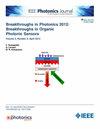单片钙钛矿/硅串联太阳能电池的光管理途径
IF 2.4
4区 工程技术
Q3 ENGINEERING, ELECTRICAL & ELECTRONIC
引用次数: 0
摘要
全结构钙钛矿/硅串联太阳能电池已成为下一代光伏电池的有希望的候选者。然而,完全纹理的光学功能还没有被完全理解。一个关键的挑战是对钙钛矿层纹理的要求,这通常会导致电损耗增加。在这里,我们利用光学模拟阐明了前后纹理在串联配置中的不同光学作用,并利用这些见解提出了一种新的架构,消除了对钙钛矿表面纹理的需求。我们证明,我们提出的结构实现了与全纹理器件相当的光学结果,而其平面钙钛矿层具有减少电损耗的潜力。如果假设纹理诱导的电压损耗低至50 mV,则高光学性能也会带来更高的效率,这比全纹理器件的损耗低约六倍,从而在简化的设计中实现更高的效率。我们的研究结果表明,钙钛矿纹理对于最佳光管理不是必需的,从而开辟了将高效光管理与高电性能相结合的道路。本文章由计算机程序翻译,如有差异,请以英文原文为准。
Routes for Light Management in Monolithic Perovskite/Silicon Tandem Solar Cells
Fully-textured perovskite/silicon tandem solar cells have emerged as promising candidates for next-generation photovoltaics. The optical functions of full texturing, however, are not yet fully understood. A key challenge is the requirement for perovskite layer texturing, which often leads to increased electrical losses. Here, we elucidate the distinct optical roles of front and rear textures in tandem configurations using optical simulations and use these insights to propose a new architecture that eliminates the need for perovskite surface texturing. We demonstrate that our proposed structure achieves optical results comparable to those of fully-textured devices, while its planar perovskite layer has the potential to reduce electrical losses. The high optical performance also results in higher efficiency if a texture-induced voltage loss as low as 50 mV is assumed, which is about six times lower than the loss of fully-textured devices, thus enabling higher efficiencies within a simplified design. Our results show that perovskite texturing is not essential for optimal light management, thus opening the way to combine efficient light management with high electrical performance.
求助全文
通过发布文献求助,成功后即可免费获取论文全文。
去求助
来源期刊

IEEE Photonics Journal
ENGINEERING, ELECTRICAL & ELECTRONIC-OPTICS
CiteScore
4.50
自引率
8.30%
发文量
489
审稿时长
1.4 months
期刊介绍:
Breakthroughs in the generation of light and in its control and utilization have given rise to the field of Photonics, a rapidly expanding area of science and technology with major technological and economic impact. Photonics integrates quantum electronics and optics to accelerate progress in the generation of novel photon sources and in their utilization in emerging applications at the micro and nano scales spanning from the far-infrared/THz to the x-ray region of the electromagnetic spectrum. IEEE Photonics Journal is an online-only journal dedicated to the rapid disclosure of top-quality peer-reviewed research at the forefront of all areas of photonics. Contributions addressing issues ranging from fundamental understanding to emerging technologies and applications are within the scope of the Journal. The Journal includes topics in: Photon sources from far infrared to X-rays, Photonics materials and engineered photonic structures, Integrated optics and optoelectronic, Ultrafast, attosecond, high field and short wavelength photonics, Biophotonics, including DNA photonics, Nanophotonics, Magnetophotonics, Fundamentals of light propagation and interaction; nonlinear effects, Optical data storage, Fiber optics and optical communications devices, systems, and technologies, Micro Opto Electro Mechanical Systems (MOEMS), Microwave photonics, Optical Sensors.
 求助内容:
求助内容: 应助结果提醒方式:
应助结果提醒方式:


